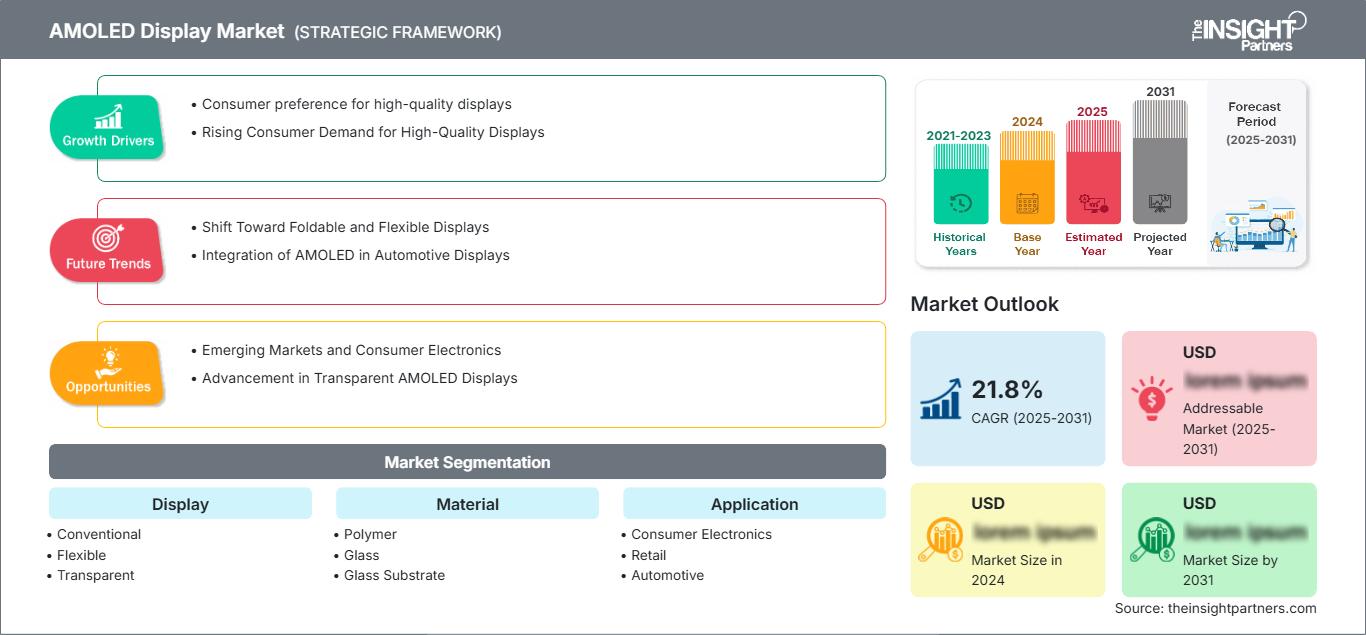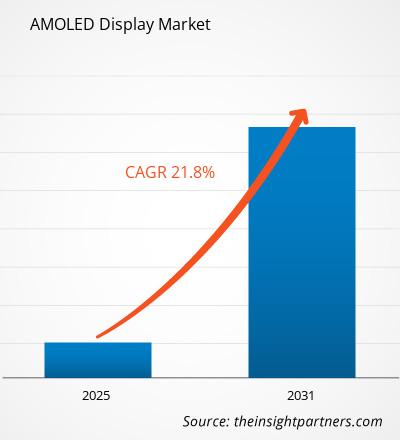Der AMOLED-Display-Markt wird voraussichtlich zwischen 2025 und 2031 eine durchschnittliche jährliche Wachstumsrate (CAGR) von 21,8 % verzeichnen, wobei die Marktgröße von XX Millionen US-Dollar im Jahr 2024 auf XX Millionen US-Dollar im Jahr 2031 anwachsen wird.
Der Bericht ist nach Display (konventionell, flexibel, transparent, 3D), Material (Polymer, Glas, Glassubstrat) und Anwendung (Unterhaltungselektronik, Einzelhandel, Automobil, Gesundheitswesen, Sonstige) segmentiert. Die globale Analyse ist weiter nach Regionen und wichtigen Ländern aufgeschlüsselt. Der Bericht bietet den Wert in USD für die obige Analyse und Segmente.
Zweck des Berichts
Der Bericht „AMOLED-Display-Markt“ von The Insight Partners zielt darauf ab, die aktuelle Situation und das zukünftige Wachstum sowie die wichtigsten treibenden Faktoren, Herausforderungen und Chancen zu beschreiben. Dadurch erhalten verschiedene Geschäftsinteressenten Einblicke, beispielsweise:
- Technologieanbieter/-hersteller: Um die sich entwickelnde Marktdynamik zu verstehen und die potenziellen Wachstumschancen zu kennen, sodass sie fundierte strategische Entscheidungen treffen können.
- Investoren: Um eine umfassende Trendanalyse hinsichtlich der Marktwachstumsrate, der finanziellen Marktprognosen und der Chancen entlang der Wertschöpfungskette durchzuführen.
- Regulierungsbehörden: Um Richtlinien und Überwachungsaktivitäten auf dem Markt zu regulieren, mit dem Ziel, Missbrauch zu minimieren, das Vertrauen der Investoren zu wahren und die Integrität und Stabilität des Marktes aufrechtzuerhalten.
AMOLED-Display-Marktsegmentierung Display
- Konventionell
- Flexibel
- Transparent
- 3D
Material
- Polymer
- Glas
- Glassubstrat
Anwendung
- Unterhaltungselektronik
- Einzelhandel
- Automobilindustrie
- Gesundheitswesen
- Sonstige
Geografie
- Nordamerika
- Europa
- Asien-Pazifik
- Süd- und Mittelamerika
- Naher Osten und Afrika
Sie erhalten kostenlos Anpassungen an jedem Bericht, einschließlich Teilen dieses Berichts oder einer Analyse auf Länderebene, eines Excel-Datenpakets sowie tolle Angebote und Rabatte für Start-ups und Universitäten.
AMOLED-Display-Markt: Strategische Einblicke

-
Holen Sie sich die wichtigsten Markttrends aus diesem Bericht.Dieses KOSTENLOSE Beispiel umfasst Datenanalysen, die von Markttrends bis hin zu Schätzungen und Prognosen reichen.
Wachstumstreiber für AMOLED-Displays
- Verbraucherpräferenz für hochwertige Displays: Die steigende Kundennachfrage nach hochwertigen visuellen Erlebnissen ist einer der Treiber für das Marktwachstum von AMOLED-Displays. Verbraucher wünschen sich zunehmend Geräte mit überlegener Displaytechnologie, die leuchtende Farben, tiefere Schwarztöne und eine höhere Energieeffizienz liefert, wie sie AMOLED-Bildschirme bieten.
- Steigende Verbrauchernachfrage nach hochwertigen Displays: Verbraucher legen mittlerweile Wert auf hochauflösende, lebendige und energieeffiziente Bildschirme, was Hersteller dazu drängt, die AMOLED-Technologie zu übernehmen. AMOLED-Displays bieten im Vergleich zu herkömmlichen LCD-Bildschirmen tiefere Schwarztöne, bessere Kontrastverhältnisse und lebendigere Farben und verbessern so das visuelle Erlebnis auf Smartphones, Fernsehern und Tablets. Da die Erwartungen der Verbraucher an eine bessere Bildqualität steigen, steigt die Nachfrage nach AMOLED-Displays in verschiedenen Anwendungen weiter an.
Zukünftige Trends im AMOLED-Displaymarkt
- Wechsel zu faltbaren und flexiblen Displays: Ein wichtiger Trend im AMOLED-Markt ist der Wechsel zu faltbaren und flexiblen Displays. Die OLED-Technologie ermöglicht dünnere, flexiblere Bildschirme, die gebogen oder gefaltet werden können, und schafft neue Möglichkeiten für innovative Produkte wie faltbare Smartphones, flexible Fernseher und sogar gebogene Displays im Fahrzeuginnenraum. Dieser Trend beschleunigt die Verbreitung von AMOLED-Displays, da sie die nächste Generation flexibler Elektronik ermöglichen.
- Integration von AMOLED in Fahrzeugdisplays: Die Automobilindustrie setzt zunehmend auf AMOLED-Technologie für Displays im Fahrzeug, da diese hohen Kontrast, tiefe Schwarztöne und hervorragende Sichtbarkeit bei allen Lichtverhältnissen bietet. AMOLED-Displays werden in Armaturenbretter, Kombiinstrumente und Infotainmentsysteme integriert und bieten ein hochwertiges, ästhetisch ansprechendes Seherlebnis. Dieser Trend spiegelt einen Wandel hin zu verbesserter Fahrzeugtechnologie und vernetzten Erlebnissen wider und treibt die Nachfrage nach AMOLED-Displays in Automobilanwendungen an.
Marktchancen für AMOLED-Displays
- Schwellenländer und Unterhaltungselektronik: Da die AMOLED-Technologie immer erschwinglicher wird, bieten die Schwellenländer im asiatisch-pazifischen Raum, Lateinamerika und Afrika ein erhebliches Wachstumspotenzial. Unternehmen der Unterhaltungselektronik in diesen Regionen setzen zunehmend AMOLED-Displays in Smartphones, Fernsehern und anderen Geräten ein, um mit globalen Marken konkurrieren zu können. Die wachsende Mittelschicht und das steigende verfügbare Einkommen in diesen Regionen treiben das Wachstum von Produkten mit AMOLED-Technologie voran.
- Fortschritte bei transparenten AMOLED-Displays: Die Entwicklung transparenter AMOLED-Displays stellt eine vielversprechende Chance für den Markt dar. Diese Displays können in einer Vielzahl von Anwendungen eingesetzt werden, beispielsweise in Head-up-Displays (HUDs) im Automobilbereich, Augmented-Reality-Systemen (AR) und sogar in der Beschilderung im Einzelhandel. Transparente AMOLED-Bildschirme kombinieren hohe Bildqualität mit innovativem Design und eröffnen neue Möglichkeiten für Branchen, die Displays nahtlos in reale Umgebungen integrieren möchten.
Regionale Einblicke in den AMOLED-Displaymarkt
Die Analysten von The Insight Partners haben die regionalen Trends und Faktoren, die den AMOLED-Display-Markt im Prognosezeitraum beeinflussen, ausführlich erläutert. In diesem Abschnitt werden auch die Marktsegmente und die geografische Lage von AMOLED-Displays in Nordamerika, Europa, im asiatisch-pazifischen Raum, im Nahen Osten und Afrika sowie in Süd- und Mittelamerika erläutert.
Umfang des AMOLED-Display-Marktberichts
| Berichtsattribut | Einzelheiten |
|---|---|
| Marktgröße in 2024 | US$ XX million |
| Marktgröße nach 2031 | US$ XX Million |
| Globale CAGR (2025 - 2031) | 21.8% |
| Historische Daten | 2021-2023 |
| Prognosezeitraum | 2025-2031 |
| Abgedeckte Segmente |
By Anzeige
|
| Abgedeckte Regionen und Länder |
Nordamerika
|
| Marktführer und wichtige Unternehmensprofile |
|
Dichte der Marktteilnehmer für AMOLED-Displays: Auswirkungen auf die Geschäftsdynamik verstehen
Der AMOLED-Display-Markt wächst rasant, angetrieben von der steigenden Endverbrauchernachfrage aufgrund von Faktoren wie sich entwickelnden Verbraucherpräferenzen, technologischem Fortschritt und einem stärkeren Bewusstsein für die Produktvorteile. Mit steigender Nachfrage erweitern Unternehmen ihr Angebot, entwickeln Innovationen, um den Bedürfnissen der Verbraucher gerecht zu werden, und nutzen neue Trends, was das Marktwachstum weiter ankurbelt.

- Holen Sie sich die AMOLED-Display-Markt Übersicht der wichtigsten Akteure
Wichtige Verkaufsargumente
- Umfassende Abdeckung: Der Bericht analysiert umfassend Produkte, Dienstleistungen, Typen und Endnutzer des AMOLED-Display-Marktes und bietet einen ganzheitlichen Überblick.
- Expertenanalyse: Der Bericht basiert auf dem umfassenden Verständnis von Branchenexperten und Analysten.
- Aktuelle Informationen: Der Bericht gewährleistet Geschäftsrelevanz durch die Berichterstattung über aktuelle Informationen und Datentrends.
- Anpassungsoptionen: Dieser Bericht kann an spezifische Kundenanforderungen angepasst werden und passt sich optimal an die Geschäftsstrategien an.
Der Forschungsbericht zum AMOLED-Display-Markt kann daher dazu beitragen, die Branchensituation und die Wachstumsaussichten zu entschlüsseln und zu verstehen. Obwohl es einige berechtigte Bedenken geben mag, überwiegen die Vorteile dieses Berichts tendenziell die Nachteile.
- Historische Analyse (2 Jahre), Basisjahr, Prognose (7 Jahre) mit CAGR
- PEST- und SWOT-Analyse
- Marktgröße Wert/Volumen – Global, Regional, Land
- Branchen- und Wettbewerbslandschaft
- Excel-Datensatz
Aktuelle Berichte
Verwandte Berichte
Erfahrungsberichte
Grund zum Kauf
- Fundierte Entscheidungsfindung
- Marktdynamik verstehen
- Wettbewerbsanalyse
- Kundeneinblicke
- Marktprognosen
- Risikominimierung
- Strategische Planung
- Investitionsbegründung
- Identifizierung neuer Märkte
- Verbesserung von Marketingstrategien
- Steigerung der Betriebseffizienz
- Anpassung an regulatorische Trends






















 Kostenlose Probe anfordern für - AMOLED-Display-Markt
Kostenlose Probe anfordern für - AMOLED-Display-Markt